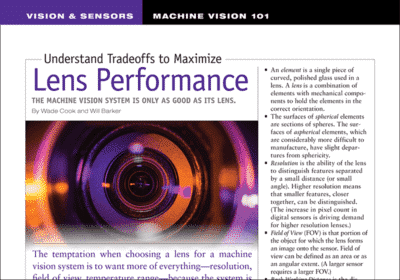The machine vision system is only as good as its lens.
By Wade Cook and Will Barker
The temptation when choosing a lens for a machine vision system is to want more of everything—resolution, field of view, temperature range—because the system is only as good as its lens. Unfortunately, increasing lens performance usually increases one or more of size, weight, and cost. This article examines some trade offs encountered when choosing a lens, then considers when a custom-designed lens might be the right choice.
For article as it appeared in Quality magazine: click here.
For purposes of this article, the following definitions apply:
- An element is a single piece of curved, polished glass used in a lens. A lens is a combination of elements with mechanical components to hold the elements in the correct orientation.
- The surfaces of spherical elements are sections of spheres. The surfaces of aspherical elements, which are considerably more difficult to manufacture, have slight departures from sphericity.
- Resolution is the ability of the lens to distinguish features separated by a small distance (or small angle). Higher resolution means that smaller features, closer together, can be distinguished. (The increase in pixel count in digital sensors is driving demand for higher resolution lenses.)
- Field of View (FOV) is that portion of the object for which the lens forms an image onto the sensor. Field of view can be defined as an area or as an angular extent. (A larger sensor requires a larger FOV.)
- Back Working Distance is the distance from the last surface of the lens to the image plane.
- Optical Speed is a measure of the light gathering ability of the lens. A lens with lower f-number is said to be faster than a lens with a higher f-number.
- Wavelength Range is that portion of the spectrum of light over which the lens provides the desired performance. (The popularity of LEDs drives demand for lenses with good performance in deep blue wavelengths.)
- Shock and Vibration Resistance is the ability of the lens to perform while (or after) being subjected to mechanical shock and vibration.
- Operating Temperature Range is the lower and upper temperature limits between which the lens is required to perform.

